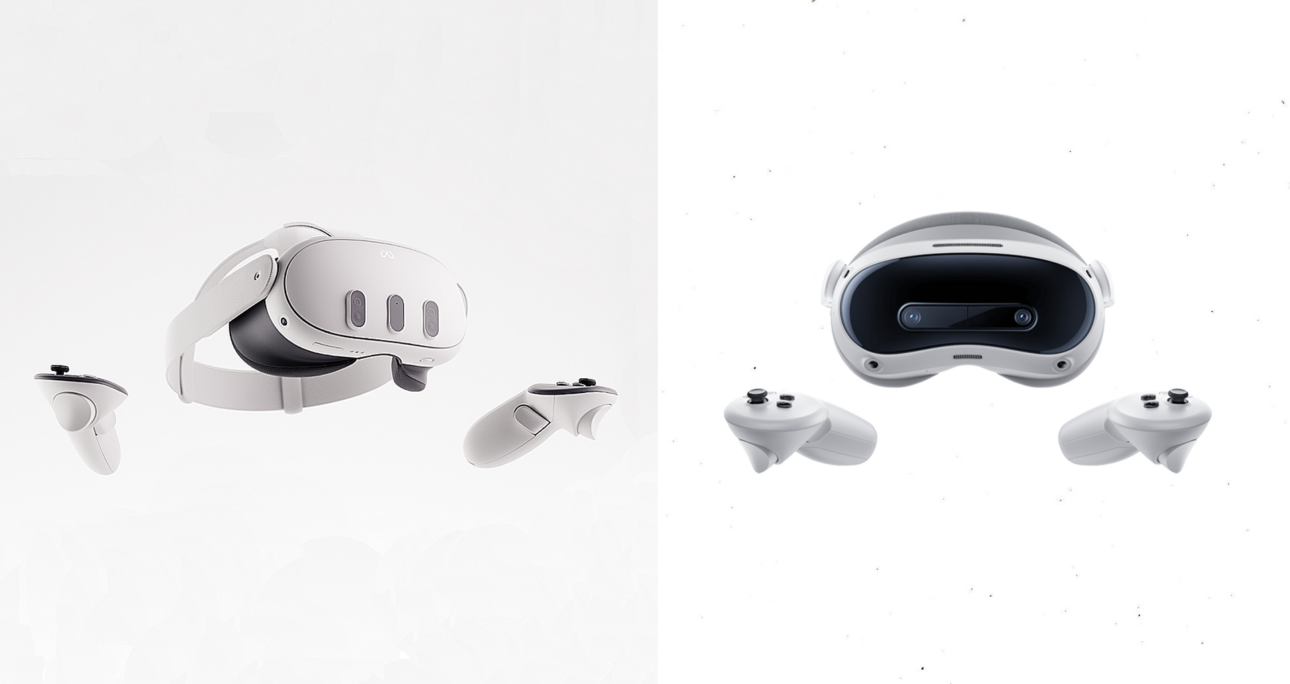Discover the strengths and differences of Meta Quest 3 and Pico 4 Ultra to find your perfect VR match.
In the ever-evolving world of virtual reality, the Meta Quest and Pico 4 Ultra are two of the most advanced headsets available today. While both headsets boast cutting-edge hardware and innovative features, they cater to different needs and preferences. Whether you’re a hardcore gamer, a productivity enthusiast, or simply someone exploring the VR landscape, this detailed comparison will help you decide which headset is the perfect fit for you.
Virtual Reality Navigation
1. Display and Visuals
Meta Quest 3:
- Resolution: 2064 x 2208 pixels per eye.
This high resolution ensures you experience sharp, clear visuals, minimizing the dreaded screen door effect. If you’re immersing yourself in detailed game environments or watching high-definition videos, this resolution provides an impressive level of clarity. - Refresh Rate: Up to 120Hz.
Gamers, rejoice! This refresh rate is perfect for fast-paced games, reducing motion blur and providing smoother visuals that keep up with your every move. - Lens Type: Pancake lenses.
These compact lenses deliver excellent clarity across the entire field of view, ensuring that even the edges of the display remain crisp and clear. - Passthrough: Full-color passthrough with stereoscopic depth perception.
Whether you’re stepping into mixed reality applications or simply navigating your physical space while wearing the headset, this feature lets you see the world around you in vivid color, making your transition between virtual and real worlds seamless.
Pico 4 Ultra:
- Resolution: 2160 x 2160 pixels per eye.
With an even higher resolution than the Quest 3, the Pico 4 Ultra is perfect for tasks where text clarity and detailed visuals are essential, like reading documents or enjoying high-resolution media. - Refresh Rate: 90Hz.
While not as high as the Quest 3, this refresh rate still offers smooth visuals while being more energy-efficient, extending battery life during longer sessions. - Lens Type: Enhanced Pancake lenses with improved brightness and color correction.
These lenses offer vibrant colors and reduce visual distortions, making the virtual world more lifelike and immersive. - Passthrough: Dual 32MP cameras (8MP per eye) with 20.6 PPD.
This high-quality passthrough not only delivers a clearer and more detailed view of your surroundings but also enhances mixed reality applications, making interactions with real-world objects in VR more accurate and engaging.
2. Performance
Meta Quest 3:
- Processor: Qualcomm Snapdragon XR2 Gen 2.
Designed specifically for VR, this processor handles complex virtual environments and detailed graphics with ease, ensuring smooth and immersive experiences without overheating. - Memory: 8GB RAM.
While adequate for most VR applications, this amount of memory might limit your ability to multitask with multiple demanding apps open at once. - Storage Options: 128GB and 512GB models.
These ample storage options let you download a variety of games and apps, but since there’s no expandable storage, you may eventually need to manage your space by deleting older content. - PCVR Connectivity: Meta’s Air Link or Virtual Desktop.
Want the best of both worlds? These features allow you to wirelessly connect to your PC for high-fidelity VR experiences, effectively turning your headset into a powerful tethered system when needed.
Pico 4 Ultra:
- Processor: Snapdragon XR2 Gen 2.
Matching the Quest 3, this processor delivers top-tier performance, ensuring smooth operation even in graphically intensive applications. - Memory: 12GB RAM.
With 12GB of RAM, the Pico 4 Ultra shines in multitasking scenarios. Imagine being surrounded by up to 20 open tabs or apps in a 360° workspace, perfect for professionals who need to manage multiple streams of information simultaneously. - Storage Options: 256GB with expandable storage via SD card.
Never worry about running out of space again. The Pico 4 Ultra’s expandable storage is perfect for users who want to store large amounts of media, apps, and games without constantly managing storage. - PCVR Connectivity: Pico Connect with Wi-Fi 7.
Experience ultra-low latency and high-speed connections, making wireless PCVR streaming smoother and more reliable—ideal for high-definition gaming or watching movies without a hitch.
3. Comfort and Design
Meta Quest 3:

- Weight: Approx. 515 grams.
Unbalanced weight at the front and rear, may require some counter-balance at the rear for comfort. - Design: Streamlined with manual IPD adjustment.
While the IPD (interpupillary distance) can be adjusted, it requires you to remove the headset. - Controllers: Ringless Touch Plus controllers with enhanced tracking.
These controllers offer better hand tracking and haptic feedback, making every interaction in VR feel more immersive and precise.
Pico 4 Ultra:

- Weight: 580 grams, balanced with a 304g front visor and 276g rear strap.
The balanced design helps distribute weight more evenly, making the headset comfortable even during long sessions. - Design: Adjustable IPD within VR.
This feature allows users to fine-tune the IPD without removing the headset, ensuring optimal visual comfort. - Controllers: Ringless controllers with haptic feedback, featuring a shorter height for a better grip.
These controllers are designed to be more ergonomic and provide precise hand tracking, particularly useful for complex hand gestures in VR applications.
4. Ecosystem and Content
Meta Quest 3:

New UI/UX Announced for META Quest
- Content Library: Access to Meta’s extensive library with exclusive titles like Asgard’s Wrath 2.
The vast library includes a mix of games, educational apps, and social experiences, making it ideal for users looking for a wide variety of content. - Ecosystem: Strong integration with Meta’s social VR applications, including Horizon Worlds and other social platforms.
This allows users to connect with friends and join VR communities seamlessly. - User Interface: Known for its ease of use, with a polished design that makes navigating through apps and settings intuitive.
Pico 4 Ultra:

Similar UI/UX to META Quest
- Content Library: Access to Pico’s proprietary store and SteamVR.
While the library is smaller compared to Meta’s, it includes key productivity apps and access to a broader range of PCVR games via Steam. - Ecosystem: Enhanced for productivity with PanoScreen Workspace.
The 360° screen allows multiple windows to be open and resized, making it ideal for multitasking. For instance, users can have up to 20 tabs open at once, surrounding themselves with information, which is invaluable for users who need to manage several tasks simultaneously. - User Interface: Features a 360° PanoScreen and advanced multitasking capabilities.
Although it is still evolving and may not be as polished as Meta’s interface, the ability to mirror Mac, Windows, iOS, and Android screens directly to the headset adds significant versatility, especially for professional use.
5. Mixed Reality and Hand Tracking
Meta Quest 3:
- Mixed Reality: Offers advanced MR features with full-color passthrough and stereoscopic depth perception.
The ability to see and interact with your surroundings in real time is crucial for immersive MR experiences, allowing for applications that blend the virtual and real worlds seamlessly. - Hand Tracking: Enhanced with AI-driven improvements.
The hand tracking is reliable for most applications but may not be as precise as the systems offered by newer competitors like Pico or Apple’s Vision Pro.
Pico 4 Ultra:
- Mixed Reality: Superior MR with dual 32MP cameras and Pico’s proprietary environment perception algorithm for real-time mapping of the environment and objects.
This allows for highly detailed MR experiences, where the virtual and real worlds interact smoothly, making it ideal for professional MR applications and complex spatial tasks. - Hand Tracking: High precision with 6DoF motion tracking and a low latency of 20 milliseconds.
This ensures that hand movements are captured accurately and in real-time, which is essential for applications requiring fine motor skills, such as virtual sculpting or detailed object manipulation.
6. Special Features and Accessories
Meta Quest 3:
- Special Features: Integration with social platforms allows users to stay connected with friends and communities even while in VR.
The headset’s high-fidelity passthrough also supports stereoscopic depth perception, making it easier to interact with real-world objects while in VR. - Accessories: Includes a variety of first-party accessories like Elite Straps and Face Interface kits, which enhance comfort and immersion.
Pico 4 Ultra:
- Special Features: PanoScreen Workspace, allowing for flexible and expansive screen management.
Users can bring memories to life with the ability to capture, edit, and watch spatial videos directly on the headset, similar to features on high-end smartphones like the iPhone 15. - Accessories: Pico Motion Tracker for full-body tracking, providing a cost-effective solution for users who want to add more immersion to their VR experience.
The ability to use external keyboards, mice, and other peripherals also enhances its versatility, especially for productivity.

7. Price and Value
Meta Quest 3:
- Pricing: $499 for the 128
GB version and $649 for the 512GB version.
- Value Proposition: Offers a comprehensive package with access to a vast content library, a polished user interface, and strong social integration, making it ideal for users who want a well-rounded VR experience.
Pico 4 Ultra:
- Pricing: Approximately $600.
- Value Proposition: Provides excellent value for users interested in advanced mixed reality capabilities, productivity features, and superior PCVR connectivity.
The inclusion of more RAM and the ability to expand storage make it particularly appealing to professionals and power users.
Detailed Comparison Chart
| Feature | Meta Quest 3 | Pico 4 Ultra |
|---|---|---|
| Resolution | 2064 x 2208 pixels per eye | 2160 x 2160 pixels per eye |
| Refresh Rate | Up to 120Hz | 90Hz |
| Processor | Snapdragon XR2 Gen 2 | Snapdragon XR2 Gen 2 |
| Memory | 8GB RAM | 12GB RAM |
| Passthrough | Full-color, high fidelity | Dual 32MP cameras with low distortion |
| Weight | 515 grams | 580 grams |
| Storage | 128GB/512GB | 256GB (expandable via SD card) |
| Controllers | Ringless Touch Plus | Ringless, ergonomic with better haptics |
| Ecosystem | Extensive Meta library | Smaller, with strong productivity focus |
| PCVR Support | Meta Air Link/Virtual Desktop | Pico Connect with Wi-Fi 7 |
| Price | $499 – $649 | $600 |
Conclusion
Choose Meta Quest 3 if:
- You prioritize a high refresh rate for smooth gaming experiences.
- You value a large, diverse library of VR content with exclusive titles.
- You need a polished, user-friendly interface with deep social integration.
Choose Pico 4 Ultra if:
- You want superior mixed reality capabilities with higher resolution passthrough.
- You need advanced multitasking for productivity with the ability to manage multiple tabs and apps in a 360° workspace.
- You prefer better PCVR integration with the latest Wi-Fi 7 technology for ultra-low latency streaming.




